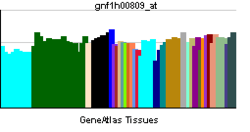GPR81
| HCAR1 | |||||||||||||||||
|---|---|---|---|---|---|---|---|---|---|---|---|---|---|---|---|---|---|
| Identifiers | |||||||||||||||||
| Aliases | HCAR1, GPR104, GPR81, HCA1, LACR1, TA-GPCR, TAGPCR, FKSG80, hydroxycarboxylic acid receptor 1 | ||||||||||||||||
| External IDs | MGI: 2441671 HomoloGene: 13060 GeneCards: HCAR1 | ||||||||||||||||
| Targeted by Drug | |||||||||||||||||
| niacin, 3,5-dihydroxybenzoic acid, 4-hydroxybutanoic acid[1] | |||||||||||||||||
| |||||||||||||||||
| RNA expression pattern | |||||||||||||||||
 | |||||||||||||||||
| More reference expression data | |||||||||||||||||
| Orthologs | |||||||||||||||||
| Species | Human | Mouse | |||||||||||||||
| Entrez | |||||||||||||||||
| Ensembl | |||||||||||||||||
| UniProt | |||||||||||||||||
| RefSeq (mRNA) | |||||||||||||||||
| RefSeq (protein) |
| ||||||||||||||||
| Location (UCSC) | Chr 12: 122.73 – 122.73 Mb | Chr 5: 123.88 – 123.88 Mb | |||||||||||||||
| PubMed search | [2] | [3] | |||||||||||||||
| Wikidata | |||||||||||||||||
| View/Edit Human | View/Edit Mouse |
G protein-coupled receptor 81, also known as GPR81, is a protein that in humans is encoded by the GPR81 gene.[4][5]
G protein-coupled receptors (GPCRs, or GPRs), such as GPR81, contain 7 transmembrane domains and transduce extracellular signals through heterotrimeric G proteins.[4]
Lactate activates the GPR81 receptor which in turn inhibits lipolysis in fat cells.[6][7]
References
- ↑ "Drugs that physically interact with Hydroxycarboxylic acid receptor 1 view/edit references on wikidata".
- ↑ "Human PubMed Reference:".
- ↑ "Mouse PubMed Reference:".
- 1 2 "Entrez Gene: GPR81 G protein-coupled receptor 81".
- ↑ Lee DK, Nguyen T, Lynch KR, Cheng R, Vanti WB, Arkhitko O, Lewis T, Evans JF, George SR, O'Dowd BF (September 2001). "Discovery and mapping of ten novel G protein-coupled receptor genes". Gene. 275 (1): 83–91. doi:10.1016/S0378-1119(01)00651-5. PMID 11574155.
- ↑ Liu C, Wu J, Zhu J, Kuei C, Yu J, Shelton J, Sutton SW, Li X, Yun SJ, Mirzadegan T, Mazur C, Kamme F, Lovenberg TW (January 2009). "Lactate inhibits lipolysis in fat cells through activation of an orphan G-protein-coupled receptor, GPR81". The Journal of Biological Chemistry. 284 (5): 2811–22. doi:10.1074/jbc.M806409200. PMID 19047060.
- ↑ Cai TQ, Ren N, Jin L, Cheng K, Kash S, Chen R, Wright SD, Taggart AK, Waters MG (December 2008). "Role of GPR81 in lactate-mediated reduction of adipose lipolysis". Biochemical and Biophysical Research Communications. 377 (3): 987–91. doi:10.1016/j.bbrc.2008.10.088. PMID 18952058.
Further reading
- Takeda S, Kadowaki S, Haga T, Takaesu H, Mitaku S (June 2002). "Identification of G protein-coupled receptor genes from the human genome sequence". FEBS Letters. 520 (1-3): 97–101. doi:10.1016/S0014-5793(02)02775-8. PMID 12044878.
- Mao M, Biery MC, Kobayashi SV, Ward T, Schimmack G, Burchard J, Schelter JM, Dai H, He YD, Linsley PS (June 2004). "T lymphocyte activation gene identification by coregulated expression on DNA microarrays". Genomics. 83 (6): 989–99. doi:10.1016/j.ygeno.2003.12.019. PMID 15177553.
- Madaan A, Nadeau-Vallée M, Rivera JC, Obari D, Hou X, Sierra EM, Girard S, Olson DM, Chemtob S (September 2016). "Lactate produced during labor modulates uterine inflammation via GPR81 (HCA1)". American Journal of Obstetrics and Gynecology. doi:10.1016/j.ajog.2016.09.072. PMID 27615440.
This article is issued from Wikipedia - version of the 10/27/2016. The text is available under the Creative Commons Attribution/Share Alike but additional terms may apply for the media files.